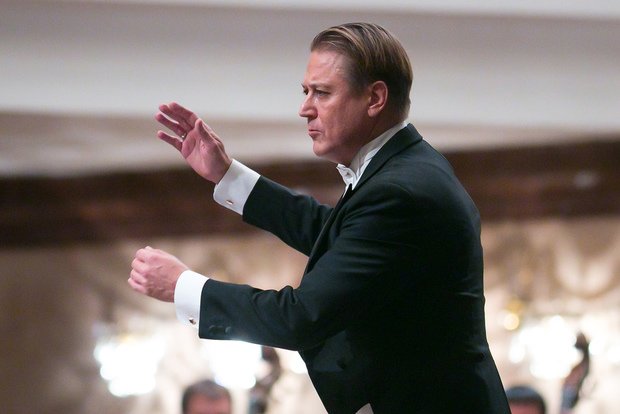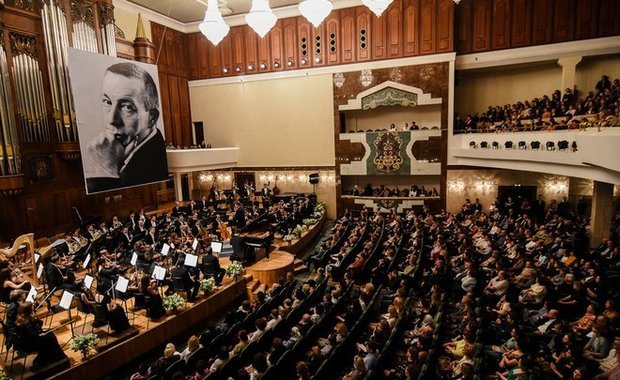Rakhmaninov. Lilac. Take eight
Sergey Rakhmaninov White Lilac International Festival took place in the S. Saydashev State Big Concert Hall on 2 June. Realnoe Vremya tells how Yury Bashmet performed in front of Kazan citizens in an unusual role.
Soul's spring
It seems it was difficult to make up the best time and name for White Lilac festival. The topic of spring renewal is present in Sergey Rakhmaninov's work. And white lilac, this tender symbol of late spring, was Mr Rakhmaninov's favourite flower.
White Lilac international festival founded by Art Director of the Tatarstan State Symphony Orchestra Aleksandr Sladkovsky has been held in Kazan for the eighth time. Concerts will be given during the month. Also, this year the festival is dedicated to the Football World Cup, that's to say, it is included in its cultural programme.
The poster has five concerts and plenty of famous names: Yury Bashmet, Olli Mustonen, Denis Matsuyev, Polina Osetinskaya, Yekaterina Mechetina, Dmitry Masleyev and others. The final concert, which will be in July, can be called a presentation – young talents whose victories in contests are still ahead will appear on the stage. Unfortunately, master Sladkovsky will be behind the desk only in one of five concerts. We can't help but remember Andrey Voznesensky's line: ''How much I miss you!''

However, the first concert of the festival, which gathered a fantastic number of spectators in the Big Concert Gall – the audience was sitting in choir balconies, bravely standing in the aisles during the whole programme – not only didn't disappoint listeners but also set a high bar to whole White Lilac. Yury Bashmet, in his unchangeable black blouse whom citizens of Kazan used to see with aviola in his arms, occupied the seat behind the conductor's desk. Sergey Rakhmaninov's portrait was looking at the hall with a bit slanting eyes. The apron stage was surrounded by bunches of white lilac, master Sladkovsky was in the right box. The first part was given to probably one of the most famous compositions of Rakhmaninov – his second concert for piano with orchestra.
Olli Mustonen's powerful brutal chord were the best seconds of the concert, as if the sounds had been freed. Rakhmaninov's Concerto No. 2, which was created in the early last century, was written after the composer suffered from severe depression. In fact, this concert is a symbol of recovery, renewal, soul's spring when there is a great desire to put your face under the wind, open your arms with a fantastic will to hug the earth. Yury Bashmet interpreted Rakhmaninov's Concerto No. 2 like an anthem of life.
The pianist made sounds strike like sparks. In small pauses, Mustonen wiped the sweat on his sleeve. The second part of the concert is tender, lyric, and, at the same time, a romantic song to the earthly world. And the final, it's when the lyric theme turns into the anthem to Human, God's best creation. The audience didn't let Mustonen go, and he played an encore.

Human life
The second part of the concert is Symphonic Dances, the last symphony composition of Rakhmaninov. We should note the concert programme was diverse.
Symphonic Dances were written by the composer in 1939 when Germany occupied Poland, Rakhmaninov had the time to go to America with his wife. But his daughter whose fate was unknown left in Paris. Agonised by the concern about her, thoughts about the world's fate, Rakhmaninov created Symphonic Dances in America, living on the seashore.
The three parts – Day, Twilight and Midnight – are, of course, not day times but stages of human life. This is how this composition of Rakhmaninov full of dramatism is interpreted, from a philosophic point of view.
Charismatic Yury Bashmet seemed to be taking the listeners through these periods of human life: from a kind of march of the first part to the second, which is light and lyric. And, finally, the third part is the most dramatic one whose theme came from Middle Ages, these awful dances of death, the image of doom, which is so loved by Russian romantics of the Silver Age. And the memory of Mr Rakhmaninov's All-Night Vigil miraculously appeared through the gloom.
Bashmet as a conductor is no less interesting than Bashmet as a violist. The infernality of ''violist Danilov'', though very Mr Bashmet categorically denied in an interview to the author of these lines, was a prototype of the main character of Vladimir Orlov's novel, which gives certain charm to his work in any form. It's what the concert of White Lilac festival showed.